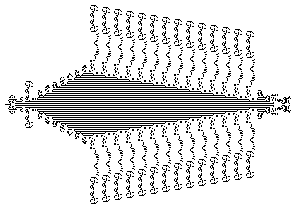c/5 orthogonal
c/5 orthogonal is an orthogonal speed that is equivalent to one fifth of the speed of light.
| c/5 orthogonal | ||
| Spaceship | Yes | |
|---|---|---|
| Puffer | Yes | |
| Rake | Yes | |
| Wickstretcher | Yes | |
| Gun | Yes | |
Spaceships
The first c/5 orthogonal spaceship to be discovered was the snail, found by Tim Coe in January 1996 using a program designed to utilize two CPUs. Since then many c/5 orthogonal spaceships have been found, most notably the spider, discovered by David Bell in April 1997, which is the smallest c/5 orthogonal spaceship known. Hartmut Holzwart found the first c/5 greyship in March 2010.[1]

All known c/5 orthogonal spaceships were period-5 until the discovery of the p15 pre-pulsar spaceship by Noam Elkies in December 1997. David Bell found two related ships, the p30 pre-pulsar spaceships in May, 1998. In March 1998 David Bell found methods of constructing high period c/5 orthogonal spaceships by perturbing gliders with the edge sparks of spiders. Paul Tooke found the first period 10 spaceship of this speed, 160P10H2V0, in November 2004, and on January 4, 2005, constructed an adjustable period rake with period 165 + 5N, which could easily be made into a spaceship by adding an extra spider to delete the outgoing gliders.
Puffers
The first c/5 orthogonal puffer to be discovered was found by Tim Coe in May, 1997. The puffer works by perturbing a reaction between a block and a glider using six spiders, so that the appropriate gliders are sent to the other side of the pattern where the process is repeated. Since then new methods of perturbing gliders have resulted in much cleaner puffers.
Rakes
In September 1997 David Bell discovered the first clean c/5 orthogonal rake. The rake had a period of 3960 and was based on the same mechanisms as the other known puffers. Many rakes of smaller periods were later formed, often by circulating more gliders in higher period rakes. On January 4, 2005 Paul Tooke constructed an adjustable forward rake of period 165+5N.
Wickstretchers
On March 12, 2013 Matthias Merzenich found a c/5 orthogonal wickstretcher for a period-12 wick.[2] On June 7, 2020, he completed another wickstretcher with adjustable width using components by Keith Amling and Hartmut Holzwart.[3]
Guns
On March 7, 2019, Martin Grant found a 601-glider synthesis of spider, making it the first c/5 orthogonal spaceship to be synthesized.[4] On January 26, 2020, Entity Valkyrie constructed a p11040 spider gun using an old 384-glider recipe, the first gun to fire a c/5 orthogonal spaceship and the largest gun of an elementary spaceship by far in both respect of bounding box (15426×15954) and population (263246).[5]
See also
- c/5 diagonal
- List of important speeds
- List of spaceships with speed c/5
- List of puffers with speed c/5
References
- Hartmut Holzwart (March 22, 2010). c/5 grey ship (discussion thread) at the ConwayLife.com forums
- Matthias Merzenich (March 12, 2013). c/5 wickstretcher (discussion thread) at the ConwayLife.com forums
- Matthias Merzenich (June 7, 2020). Re: Spaceship Discussion Thread (discussion thread) at the ConwayLife.com forums
- Martin Grant (March 7, 2019). Re: Small Spaceship Syntheses (discussion thread) at the ConwayLife.com forums
- Entity Valkyrie (January 26, 2020). Re: Small Spaceship Syntheses (discussion thread) at the ConwayLife.com forums
- David Bell's c/5 orthogonal object archive
- Jason Summers' Game of Life Status page
- Jason Summers' jslife pattern collection.